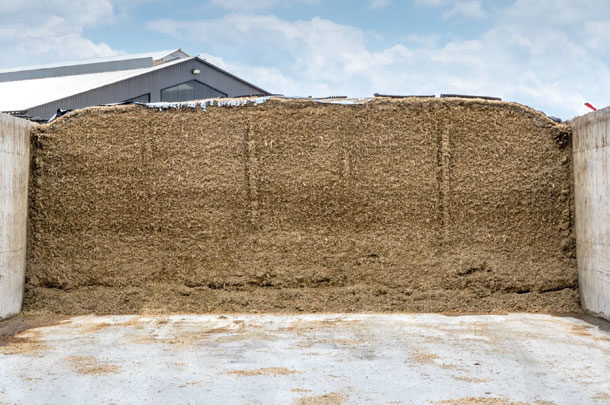However, there are several helpful tables and rules of thumb that can help determine the amount of inventory you have on hand and how much you will need to finish the season.
Bunkers
Bunkers can be one of the easier storage options for calculating tons remaining. Table 1 from the University of Wisconsin shows the number of wet tons different bunker sizes hold.

Take note: This table is at 65 percent moisture. Wetter silage being stored in the bunker will have fewer tons held than the table shows, and drier silage will have more tons.
Also, at this time of year, bunkers are not usually full, and we need to figure out how many tons are left. There are many interactive online options available that will calculate tons remaining, including online at DuPont Pioneer.
Upright silo dimensions
Silos can be a little more difficult when you want to calculate how much feed is remaining. The University of Wisconsin has numerous charts and tables that show the tonnage varying sizes of silos will hold.
Table 2 is one of these tables showing by feet what can be held in a silo depending on diameter.
Click here or on the image above to view it at full size in a new window.
Bagged silos inventory
There has been an increase in bags used for storage because of their versatility. For some, they are a permanent storage option. For others, bags are a “stepping stone” before building a more permanent structure or for temporary storage until there is room in their other silos.
If managed appropriately, bags are a great way to store feed and should ideally be placed on a hard surface. You can easily put up another bag to help feed the growing herd or help build up inventory.
Some producers will put up a small bag at corn silage harvest and not open until the following year at harvest so the cows receive fully fermented feed throughout the entire year.
To calculate the amount of feed you can hold or to calculate your remaining feed in bags, see Table 3.

If you have concluded corn silage inventory may be running low until this year’s crop harvest, there are several options available to extend your current corn silage inventory.
It is very important to work with your nutritionist to determine which of the available options will be the best fit for your herd from a performance and return-on-investment perspective. This will differ from herd to herd depending on inventory of other forages, as well as the availability of other purchased feedstuffs.
The first and simplest option is to alter the ratio of forages in your ration by reducing the total amount of corn silage being fed and increasing other forages, usually haylage.
This change will result in lower protein requirements in the concentrate portion of your ration and a need for increased energy that can come a starchy feed – like high-moisture or ground corn – or from another source, like bakery meal.
Beet pulp is another option very useful for replacing a portion of corn silage in the ration. Beet pulp can be purchased in either wet form (75 percent moisture) or in a dry pelleted form depending on the time of year.
Brewers grains, cottonseed and distillers grains are other commodities generally available in eastern Canada and can supplement a ration to help replace part of the corn silage’s energy portion.
However, many of these commodities are high in concentrates and do not help to replace the fibre portion of the corn silage.
This can be done by increasing haylage, adding straw to the ration or adding a non-forage fibre source in conjunction, such as oat hulls, ground corn cobs or soyhulls.
The direction you choose will be largely based on how long you need to extend your silage inventory, the availability of alternative products in your local area and, of course, the return on investment these purchased feeds will provide your operation.
Regardless of the approach you think will work for your operation, it is important to work with your nutrition professional. This way, you ensure the changes you hope to make will result in a balanced diet with a good return-over-feed-cost that will allow your cows to continue performing to their potential. ![]()
PHOTO: Silage pit. Photo by Mike Dixon.

-
Martina Pfister
- Ontario Dairy Specialist
- DuPont Pioneer
- Email Martina Pfister











